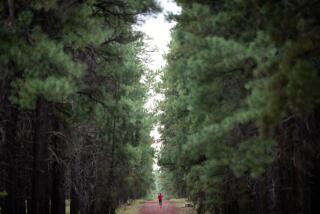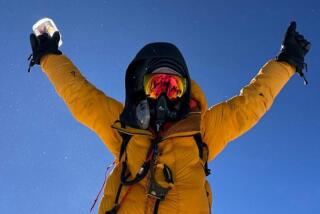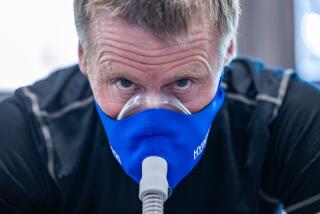A Top Spot for Higher Education
- Share via
Looking small and vulnerable, dozens of college students fanned out among the crags and steep slopes of White Mountain Peak hoping to unlock the secrets of the world’s high places.
They ducked between boulders to examine lichens or chronicled the social life of marmot colonies. A few caught butterflies, others studied climate change.
“In California there are no other field stations at this altitude,” said Thea Wang, a UCLA graduate student studying marmot behavior. “It’s a big advantage to be able to live here and walk out and be with the marmots.”
At 14,246 feet, White Mountain Research Station’s laboratory is the highest facility of its kind in North America. Scientists and students from all over the world come to the study the effects of altitude on humans, animals and plants. They also investigate climate change, using sensors on peaks throughout the White Mountains. The station’s observatory analyzes radiation from space.
Founded in 1950 by the U.S. Navy, the research center is made up of four stations at varying altitudes -- 4,000 feet in Bishop, 10,200 feet at Crooked Creek, 12,500 at Barcroft and, at 14,246 feet, a small hut on the summit of White Mountain Peak.
“This was started to study the effects of low oxygen on human physiology,” said John Smiley, an entomologist and associate director of the station. “The White Mountains are perfect. They are dry, flat on top and easy to get around.”
The landscape is so otherworldly that components of the Mars rover were tested at the station. Research is also being done on altitude sickness to see if the optic nerve expands at higher elevations, causing headaches and other symptoms of the illness.
“The biggest question here for human physiology is who gets acute mountain sickness and who doesn’t,” Smiley said. “Another question is how you can avoid pulmonary and cerebral edema, which is fatal if you don’t get down the mountain.”
The facility, run by UC San Diego, has found evidence that plants and animals are increasingly moving up the mountain in response to global climate change.
“Usually plants can’t go beyond a certain level because of the cold, but with warming we are seeing them moving up the slopes,” Smiley said. “You can see it with sagebrush and the bristlecone pine. We have also found vegetation moving into mountain valleys that used to be too cold at night to support them.”
Aerial photos from the 1960s and today show a marked increase in vegetation at higher altitudes, he said.
Except for the Bishop station, getting to the other sites can be difficult. Barcroft is more than a two-hour drive over rough, unpaved roads. The journey passes stands of bristlecone pine, among the earth’s oldest living things, with the most ancient estimated at 4,789 years old.
In comparison with the Sierra Nevada, the less-visited White Mountains are smooth, barren and desert-like. Their whiteness comes from heavy dolomite deposits. The undulating tableau seems alien, yet everywhere there is life -- marmots, bighorn sheep, beetles, eagles and at least one wild horse.
Barcroft station is a 100-by-40-foot Quonset hut with labs, a cafeteria and living quarters set in rock-strewn terrain. It gets about 100 research visits per year by groups that pay to use its facilities. Inside are chambers where the effect of altitude on sleep is measured and where oxygen levels can be altered to simulate the atmosphere at 16,400 feet.
Life is challenging for the full-time staff. Michael Pawlish, the station’s chef, has to deal with the sometimes bizarre effects of altitude on cooking. Food doesn’t get done quickly, and less air pressure means containers expand in every direction.
“I have to cook a potato for two hours up here,” he said. “The chip bags look like balloons. The ice cream blows up.”
The cafeteria has two oxygen bottles in case someone needs to stave off altitude sickness.
Pregnant sheep bleat in a pen outside. When it’s time to give birth they are taken down the mountain so researchers at Loma Linda University can study how low oxygen affects the developing fetus.
Paul Addison, a full-time staffer, takes care of the animals and is often here when everyone else is gone. The station closes from the end of October to June 31, but a winter caretaker remains.
“It takes a while to get used to the isolation, and communications can be a problem,” he said. “If you get a toothache you’re out of luck. The extremes are pretty stark. You go from having to stand in line to take a shower to having no one around. I spent a winter up here once. It can be unnerving to be alone; the mind can play tricks on you.”
Researchers sometimes spend months here close to their subjects.
Rowan Sage, a botany professor, recently brought one of his classes from the University of Toronto.
“At White Mountain Peak you get scattered plants with the most extreme adaptability,” he said.
His students bundled up against the fierce wind and blazing sun on the mountain.
Uvi Shah, 20, was studying how often beetles nested in certain alpine plants.
“This whole area is untouched,” she said.
Others studied the nest orientation of pikas, an animal related to the rabbit, or how butterflies keep warm while feeding.
“I feel like I’m on another planet,” said Erin Kelly, 21, who was analyzing the effects of roads and trails on plant populations.
“It looks pretty barren but there is a lot of life out here.”
A large radio telescope sits a bit farther up at 13,000 feet. UC Santa Barbara researchers are studying cosmic radiation left over from the Big Bang, a massive explosion that many believe created the universe. The observatory has also measured the climates of the moon, Mars and other planets.
“You want to be above the Earth’s atmosphere as much as possible; ideally we’d like to be in space,” said Philip Lubin, a UC Santa Barbara physics professor leading the project. “White Mountain’s main advantage is that it allows students to go up and immediately have access to front-line research.”
The summit looms just beyond the observatory, yet it’s a two- or three-hour hike away, each step increasingly difficult as the air thins. A small stone hut with two bunk beds is at the peak.
Across Owens Valley, the enormous Palisade glacier is easily seen beneath the granite spires of the Sierra. In the other direction, the dunes of Death Valley rise from the desert floor.
“This is where you bring people to make them sick,” Smiley said.
The Barcroft lab is increasingly used for such experiments because it can simulate the same atmosphere as the White Mountain site. Frank Powell, director of White Mountain Research Station, said a healthy person near the peak would experience what an emphysema sufferer would endure at sea level.
For some students, the effects were obvious.
“You see a pretty rock and pick it up and you’re out of breath,” said Stacey Gray of the University of Toronto.
Gray, 29, tried smoking as she climbed the mountain. but less oxygen made it tough to keep the cigarette burning.
“I’m so glad I came,” she said. “But I think I might stop smoking.”
*






